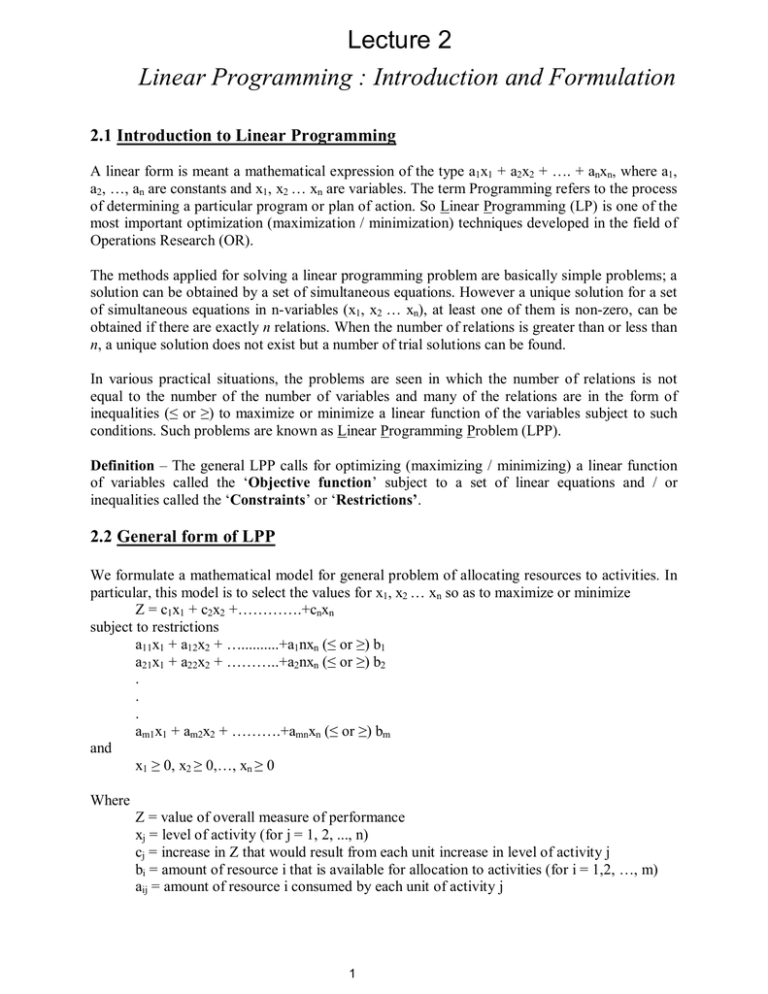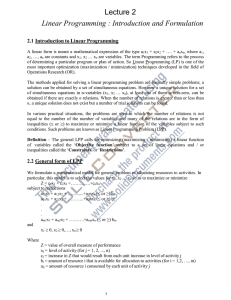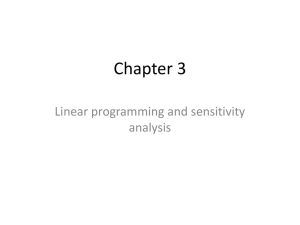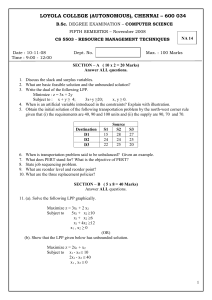2.1 Introduction to Linear Programming
advertisement

Lecture 2 Linear Programming : Introduction and Formulation 2.1 Introduction to Linear Programming A linear form is meant a mathematical expression of the type a1x1 + a2x2 + …. + anxn, where a1, a2, …, an are constants and x1, x2 … xn are variables. The term Programming refers to the process of determining a particular program or plan of action. So Linear Programming (LP) is one of the most important optimization (maximization / minimization) techniques developed in the field of Operations Research (OR). The methods applied for solving a linear programming problem are basically simple problems; a solution can be obtained by a set of simultaneous equations. However a unique solution for a set of simultaneous equations in n-variables (x1, x2 … xn), at least one of them is non-zero, can be obtained if there are exactly n relations. When the number of relations is greater than or less than n, a unique solution does not exist but a number of trial solutions can be found. In various practical situations, the problems are seen in which the number of relations is not equal to the number of the number of variables and many of the relations are in the form of inequalities (≤ or ≥) to maximize or minimize a linear function of the variables subject to such conditions. Such problems are known as Linear Programming Problem (LPP). Definition – The general LPP calls for optimizing (maximizing / minimizing) a linear function of variables called the ‘Objective function’ subject to a set of linear equations and / or inequalities called the ‘Constraints’ or ‘Restrictions’. 2.2 General form of LPP We formulate a mathematical model for general problem of allocating resources to activities. In particular, this model is to select the values for x1, x2 … xn so as to maximize or minimize Z = c1x1 + c2x2 +………….+cnxn subject to restrictions a11x1 + a12x2 + …..........+a1nxn (≤ or ≥) b1 a21x1 + a22x2 + ………..+a2nxn (≤ or ≥) b2 . . . am1x1 + am2x2 + ……….+amnxn (≤ or ≥) bm and x1 ≥ 0, x2 ≥ 0,…, xn ≥ 0 Where Z = value of overall measure of performance xj = level of activity (for j = 1, 2, ..., n) cj = increase in Z that would result from each unit increase in level of activity j bi = amount of resource i that is available for allocation to activities (for i = 1,2, …, m) aij = amount of resource i consumed by each unit of activity j 1 Resource 1 2 . . . m Contribution to Z per unit of activity Resource usage per unit of activity Activity 1 2 …………………….. n a11 a12 …………………….a1n a21 a22 …………………….a2n . . . am1 am2 …………………….amn Amount of resource available b1 b2 . . . bm c1 c2 ………………………..cn Data needed for LP model The level of activities x1, x2………xn are called decision variables. The values of the cj, bi, aij (for i=1, 2 … m and j=1, 2 … n) are the input constants for the model. They are called as parameters of the model. The function being maximized or minimized Z = c1 x1 + c2 x2 +…. +cnxn is called objective function. The restrictions are normally called as constraints. The constraint ai1x1 + ai2 x2 … ainxn are sometimes called as functional constraint (L.H.S constraint). xj ≥ 0 restrictions are called non-negativity constraint. 2.3 Assumptions in LPP a) b) c) d) e) Proportionality Additivity Multiplicativity Divisibility Deterministic 2.4 Applications of Linear Programming 1. 2. 3. 4. 5. 6. 7. 8. 9. Personnel Assignment Problem Transportation Problem Efficiency on Operation of system of Dams Optimum Estimation of Executive Compensation Agriculture Applications Military Applications Production Management Marketing Management Manpower Management 2 10. Physical distribution 2.5 Advantages of Linear Programming Techniques 1. 2. 3. 4. It helps us in making the optimum utilization of productive resources. The quality of decisions may also be improved by linear programming techniques. Provides practically solutions. In production processes, high lighting of bottlenecks is the most significant advantage of this technique. 2.6 Formulation of LP Problems Example 1 A firm manufactures two types of products A and B and sells them at a profit of Rs. 2 on type A and Rs. 3 on type B. Each product is processed on two machines G and H. Type A requires 1 minute of processing time on G and 2 minutes on H; type B requires 1 minute on G and 1 minute on H. The machine G is available for not more than 6 hours 40 minutes while machine H is available for 10 hours during any working day. Formulate the problem as a linear programming problem. Solution Let x1 be the number of products of type A x2 be the number of products of type B After understanding the problem, the given information can be systematically arranged in the form of the following table. Type of products (minutes) Machine Type A (x1 units) Type B (x2 units) G H Profit per unit 1 2 Rs. 2 1 1 Rs. 3 Available time (mins) 400 600 Since the profit on type A is Rs. 2 per product, 2 x1 will be the profit on selling x1 units of type A. similarly, 3x2 will be the profit on selling x2 units of type B. Therefore, total profit on selling x1 units of A and x2 units of type B is given by Maximize Z = 2 x1+3 x2 (objective function) Since machine G takes 1 minute time on type A and 1 minute time on type B, the total number of minutes required on machine G is given by x1+ x2 . Similarly, the total number of minutes required on machine H is given by 2x1 + 3x2. But, machine G is not available for more than 6 hours 40 minutes (400 minutes). Therefore, 3 x1+ x2 ≤ 400 (first constraint) Also, the machine H is available for 10 hours (600 minutes) only, therefore, 2 x1 + 3x2 ≤ 600 (second constraint) Since it is not possible to produce negative quantities x1 ≥ 0 and x2 ≥ 0 (non-negative restrictions) Hence Maximize Z = 2 x1 + 3 x2 Subject to restrictions x1 + x2 ≤ 400 2x1 + 3x2 ≤ 600 and non-negativity constraints x1 ≥ 0 , x2 ≥ 0 Example 2 A company produces two products A and B which possess raw materials 400 quintals and 450 labour hours. It is known that 1 unit of product A requires 5 quintals of raw materials and 10 man hours and yields a profit of Rs 45. Product B requires 20 quintals of raw materials, 15 man hours and yields a profit of Rs 80. Formulate the LPP. Solution Let x1 be the number of units of product A x2 be the number of units of product B Product A 5 10 Rs 45 Raw materials Man hours Profit Product B 20 15 Rs 80 Availability 400 450 Hence Maximize Z = 45x1 + 80x2 Subject to 5x1+ 20 x2 ≤ 400 10x1 + 15x2 ≤ 450 x1 ≥ 0 , x2 ≥ 0 Example 3 A firm manufactures 3 products A, B and C. The profits are Rs. 3, Rs. 2 and Rs. 4 respectively. The firm has 2 machines and below is given the required processing time in minutes for each machine on each product. Machine Products A B 4 C X 4 3 5 Y 2 2 4 Machine X and Y have 2000 and 2500 machine minutes. The firm must manufacture 100 A’s, 200 B’s and 50 C’s type, but not more than 150 A’s. Solution Let x1 be the number of units of product A x2 be the number of units of product B x3 be the number of units of product C Machine X Y Profit A 4 2 3 Products B 3 2 2 Max Z = 3x1 + 2x2 + 4x3 Subject to 4x1 + 3x2 + 5x3 ≤ 2000 2x1 + 2x2 + 4x3 ≤ 2500 100 ≤ x1 ≤ 150 x2 ≥ 200 x3 ≥ 50 5 C 5 4 4 Availability 2000 2500




